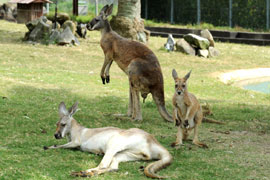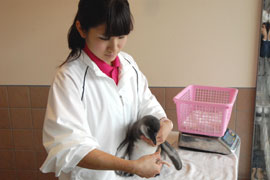Safari&Marineこんにちは!動物の赤ちゃん 〜アカカンガルー・ケープペンギン〜

アカカンガルー(2013年6月25日生まれ)
有袋目カンガルー科
英名:Red Kangaroo
学名:Macropus rufus
分布:オーストラリア
2013年6月25日、アカカンガルーの赤ちゃんが母親の袋から顔を出しているのを確認しました。ゴールデンウィーク頃に母親の袋に膨らみがあることに気づきましたが、この母親は過去に何度も育児放棄していたため心配をしていましたが、赤ちゃんの元気な顔を見ることが出来スタッフ一同ほっとしました。
有袋類であるカンガルーのメスには育児嚢という袋があり、その中で子育てを行います。妊娠期間は約1ヶ月で、体重1g程度で毛も生えていない、目も開いていない大変未熟な状態で赤ちゃんが生まれます。袋の中で母乳を飲みながら成長し、生後3〜5ヶ月頃に初めて袋から顔を出します。
日を追うごとに袋が大きくなり、袋の外からでもはっきりとごそごそ動く赤ちゃんの動きを観察できるようになりました。
その後も順調に成長し、9月頃からは袋から出ることが多くなりました。今では母親と寄り添って昼寝したり、1頭だけで元気に飛び跳ね回ったりする姿をご覧いただけます。
(森田 圭一)

ケープペンギン(2013年9月7〜11日生まれ)
ペンギン目ペンギン科
英名:Cape Penguin
学名:Spheniscus demersus
分布:南アフリカ
2013年9月7〜11日にかけて、3羽のケープペンギンのヒナが続々と孵化しました。
ケープペンギンの親鳥はお腹が白色・背中が黒色をしていますが、ヒナは茶色い姿で生まれ、綿羽と呼ばれる保温効果抜群のふわふわした羽で覆われています。
孵化直後、ピーピーと元気な声で鳴いておりひとまず安心しましたが、気を抜くことはできません。孵化したヒナは体重60g前後でとても小さく、スタッフの片手に乗ってしまうほどです。親鳥の中には子育てが苦手で、誤ってヒナを踏んでしまうこともあります。アドベンチャーワールドでも親鳥がヒナを踏んでしまうことが続いていたため、今回孵化したヒナ達は人の手で育てることにしました。
親鳥の代わりに、魚のすり身・生クリーム・オキアミ・水を混ぜて作ったペンギン専用の流動食を与えます。チューブをヒナの口から直接胃の中まで通し、流動食を流し込みます。小さな嘴、首もすわっていない孵化したばかりのヒナに餌を与えるのは想像以上に難しく、何回か失敗するともう嘴を開いてくれないこともあります。2〜3日するとヒナの体もしっかりし始め、元気な声で餌を欲求するようになりました。生後10日前後で、ニシンを小さく切ったものも食べ始め、生後2〜3ヶ月で親鳥と同じ大きさに成長し、シシャモなどの魚を丸ごと食べるようになりました。
(垣 千尋)

